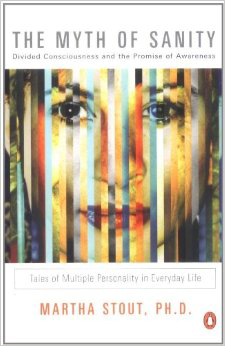Part of the Casswiki article series Books

The Myth of Sanity: Divided Consciousness and the Promise of Awareness is a book by Martha Stout, first published in 2001, which concerns psychological trauma and dissociation in everyday life and steps to the reintegration of awareness. FOTCM uses this book as a teaching tool for its members, as it is discovered that any group that wishes to work together on any kind of project needs to know themselves as well as possible so as to avoid interpersonal conflict in a working environment.
The Myth of Sanity is one of the best analysis on dissociated mental states, forgotten memories of childhood or adult trauma, and multiple personality disorders. Stout brings the tales of dissociated states or multiple personalities from her patients and her experiences with them, and how these states are often common in everyday life.
In Stout’s words, a dissociation is “the universal human reaction to extreme fear or pain…in traumatic situations, [it] mercifully allows us to disconnect emotional content - the feeling part of our ‘selves’ - from our conscious awareness” (p. 8). This term is important for everyone as it should be applied to our understanding of being self-aware, of being self-conscious. Self-awareness is extremely important because, without it, we would not have known ourselves to exist or having a sense of self-identity. It is part of who we are. When we are in a dissociated state, our self-awareness had left our bodies and is elsewhere, and our bodies are either in trance or doing what they normally do, very much like a machine.
To put it in another way as Stout pointed it out: “As the result of a daydream, this mental compartmentalization is called distraction. As the result of an involving movie, it is often called escape. As the result of trauma, physical or psychological, it is called a dissociative state” (p. 27). Whenever we are distracted, we are in a mildly dissociative state. Distraction and escape are quite familiar to everyone because they live these states almost constantly and every single day. When we are driving and thinking about something else while our automatic bodies do the driving, we are in a dissociative state. How is this so? Because our minds are away from our bodies and not focusing on the driving as we should have. We would forget our surroundings and our bodies’ reactions to those surroundings. Whenever we are distracted, our minds are detached from our bodies’ sensation to whatever object was touched. Has anyone ever noticed how they got the cut on their leg or arm and not having remembered where they have gotten it? This is one of the consequences of being in a dissociated state.
How would an understanding of “dissociation” from this book be helpful for the readers? It is a powerful understanding or clue for one to be engaged in a self-observation, which requires one to be fully conscious of one’s being and one’s surroundings. Distraction actually can hinder us to be engaged in self-observation or being self-conscious. We would lose ourselves, letting our sense of self be far away from our bodies. What if you are not in control of your bodies and your bodies are being influenced to do things that you yourself would never do? This brought us to the question of our minds being controlled or influenced without our being aware of it. But, this should not be a scary notion on the readers’ mind. We do have a choice to make: “to be or not to be.”
Stout has given us the list of signs of dissociates states in ourselves in her book and we can identify which one we would fall under. And, these includes a brief phasing out, habitual dissociative reaction, a dissociation from feeling states, intrusion of dissociated ego state, demifugue, and fugue. These signs are extremely helpful to discover the clues about ourselves and compel us to be more aware of our actions and reactions in everyday life. In order to be self-observant, one would need to develop an observing ego, as suggested by the author in this book.
If we choose to do so, we can look at ourselves and find one or more of these signs in ourselves. Once we do find these dissociative states in ourselves, we can choose not to be associated with them and to keep our self-aware active. Stout’s Myth of Sanity is a highly important study in one’s need to be engaged in self-observation or being self-conscious. Increased self-observation will help one to become more self-conscious of one’s surrounding and become more attentive to people’s action as well as one’s own.
